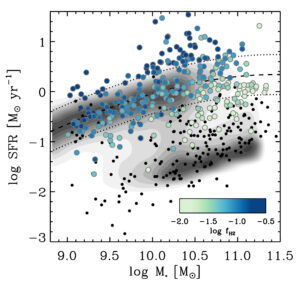xCOLD GASS: a legacy survey of molecular gas in the local Universe

CO 1-0 spectra and SDSS images of 6 galaxies observed as part of the xCOLD GASS survey.
The Extended CO Legacy Database for GASS (xCOLD GASS) is a reference survey for galaxy evolution studies: it provides a complete view of the molecular gas contents of galaxies in the nearby Universe, allowing us to investigate the interplay between cold gas and star formation, and the mechanisms that contribute to galaxy growth and quenching.
The full survey is the combination of two IRAM-30m large programs. The original COLD GASS program targeted 366 massive galaxies (log(M*/Msun)>10.0) with the IRAM-30m telescope. This was followed by a second large program to add another 166 galaxies, extending the sample down to a stellar mass limit of log(M*/Msun)=9.0.
Since cold gas is the fuel for star formation, we need a better picture of how galaxies are supplied in gas, how they process this gas into stars, and how some of the gas is then returned to the outside environment. Only then can we hope to really understand how galaxies evolve. Key aspects of the survey are: (1) a purely mass-selected, SDSS-based sample, fully representative of the local galaxy population with log(M*/Msun)>9.0 – the sample therefore includes everything from star-forming spirals to passive ellipticals, (2) a homogeneous observing strategy that allowed us to put stringent upper-limits on the molecular gas contents of passive galaxies, (3) a very rich complementary multi-wavelength dataset that allows for the derivation of robust scaling relations between the cold gas contents of galaxies (both atomic and molecular) and their stellar, star formation, chemical, and structural properties.

The 532 galaxies from xCOLD GASS represented in the star formation rate-mass plane. The galaxies are color-coded to show how molecular gas-rich they are, showing the elevated H2 contents of highly star-forming galaxies and the gas-poorness of quiescent galaxies.The smaller black symbols are galaxies undetected in CO(1-0) but with stringent upper limits. “
The xCOLD GASS data have been used to establish scaling relations between molecular gas and global physical properties of galaxies such as mass, colour, morphology, and star formation rates (Saintonge et al. 2011a, 2017). A key result of xCOLD GASS is the demonstration that star formation efficiency is not constant across the local galaxy population, but instead varies systematically (Saintonge et al. 2011b, 2012; Huang & Kauffmann 2014, 2015). In combination with its sister project at the Arecibo observatory, GASS, it has shown that the position of galaxies in the SFR-stellar mass plane is driven by their atomic and molecular gas contents and the varying star formation efficiency (Saintonge et al. 2016).
Because the xCOLD GASS sample is large, homogeneous and representative of the local galaxy population, it is perfectly suited to act as a reference for studies of particular galaxy populations (e.g. Fumagalli et al. 2012; Bothwell et al. 2014; Shimizu et al. 2015; Yesuf et al. 2017), to test and constrain the predictions of galaxy evolution models (e.g. Lagos et al. 2011, 2015; Krumholz & Dekel 2012; Kauffmann et al. 2012; Popping et al. 2012, 2015; Genel et al. 2014; Davé et al. 2017), and to anchor studies of the redshift evolution of molecular gas in galaxies (e.g. Combes et al. 2013; Saintonge et al. 2013, Genzel et al. 2015, Tacconi et al. 2017).
The official COLD GASS repository is at UCL and IRAM. The xCOLD GASS catalog provides integrated CO(1-0) and CO(2-1) line fluxes (or upper limits), with and without aperture corrections, as well as line widths and the inferred total molecular gas masses. Our public catalog also includes a range of measurements from SDSS/GALEX imaging and our Arecibo and optical spectroscopy observing campaigns. These includes among others stellar masses, star formation rates, atomic gas masses, morphological measurements, and metallicities.
Please do not hesitate to contact Amelie Saintonge and Carsten Kramer to tell them about your use of the data for scientific analysis. The following acknowledgement would be appreciated: “This work made use of the xCOLDGASS IRAM-30m legacy survey (Saintonge et al. 2011, 2017).” Acknowledgement of the xCOLD GASS project is also appreciated if data are used in public presentations.

